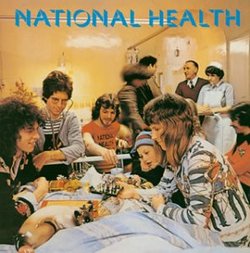Reflective jazz fusion, I suppose.
Chris Carter | my music room | 10/15/2005
(5 out of 5 stars)
"I've played this CD as much ,or more, than anything else I've gotten in the past year. I like the "rock" parts the least, which constitute maybe 30% of the album. Most of it is beautiful, reflective synthesizer-lead jazzy classical schtuff that has a wonderful '70's feel to it. (I was a small child then, so maybe it's mostly nostalgia.) When I say '70's, I don't mean disco or sensitive singer-songwriters or glam rock, but a very lesser known room of the 1970's music house, a dark room with wood paneling, and one window where you stare out at the faint December sunlight through the condensation on the glass, your childhood thoughts wandering. Just trying to give an impression of the album, y'see. And I love the photo on the back of the CD, where I'm assuming the wives and children of the band members are playing for the band.
I absolutely love the quiet parts of this disc, the gentle (mostly unaccompanied) keyboard interludes that fuel my dreaming. The whole thing is great, and even though I could do without the obligatory jazz-fusion solos, I would still give it 4 1/2 stars, just for the magical, utopian '70's keyboard sections. I am a fan of the so-called "Canterbury Scene", anyway. Mellow, melodic, imaginative music? Yes please!"
Very good Music
Brad | Clinton, Tn United States | 03/07/2005
(5 out of 5 stars)
"However, go to www.rockinworld.com to buy it, I got it for 10.00 new instead of the 30 they want here."
Dauntingly complex in the Canterbury style
Jeffrey J.Park | Massachusetts, USA | 01/02/2006
(5 out of 5 stars)
"This is great stuff released in 1977 that is completely over the top in terms of individual and ensemble virtuosity. For example, sections of Tenemos Roads are in 25/16 - yes I actually counted it out - and the melodies/harmonies are also very sophisticated as well. In fact, I stopped trying to figure out what they were up to after counting out the passages in Tenemos Roads - it just took too much time and effort! The music on this debut album is characteristic of the Canterbury style at this point in its development. Specifically, in contrast to earlier stages of Canterbury rock, which were more eclectic, the music is more thoroughly jazz rock (yet still quirky) and less emphasis is placed on other styles. The core musicians on this album are top shelf - incredible keyboardist Dave Stewart (slightly distorted organ, piano, and clavinet), excellent drummer Pip Pyle, guitarist Phil Miller (I feel that this is his best recorded performance), and great bassist Neil Murray (who displays shades of the brilliant technique of Weather Report bassist Jaco Pastorius - Neil uses harmonics, plays a fretless etc.). In addition to these core members, superb keyboardist Alan Gowen (of Gilgamesh) contributes parts on moog synthesizer, piano, authored Brujo, and co-authored the remaining pieces with Dave Stewart. Amanda Parsons reprises her role as vocalist and contributes a softer, dreamier element to the music, which can get pretty heavy at times. I should note that the pieces are largely instrumental and her vocal parts sound more like a synthesizer line than a traditional vocal part - in fact, Amanda predominantly utilizes a virtuosic vocalese style, although there are (extremely rare) instances where she will sing lyrics, albeit in a quasi-vocalese style. Other softer aspects include the use of flute and clarinet by Jimmy Hastings (guested on recordings by Caravan and Hatfield and the North). The four pieces on the album are lengthy and range from the 10'19" Brujo to the 14'43" Tenemos Roads and incorporate dynamic ranges that span full out rave-ups to quieter, more reflective moments. All in all, this is a superb album and should please most fans of Canterbury Rock."


 Track Listings (5) - Disc #1
Track Listings (5) - Disc #1